Impact of ERP Systems on Organizational Performance
VerifiedAdded on 2020/04/21
|14
|2881
|170
AI Summary
The assignment examines the benefits of Enterprise Resource Planning (ERP) systems for organizations. It highlights how ERP implementation leads to faster processes, reduced operational costs, and ultimately increased profitability, enabling businesses to regain a competitive edge in the market.
Contribute Materials
Your contribution can guide someone’s learning journey. Share your
documents today.
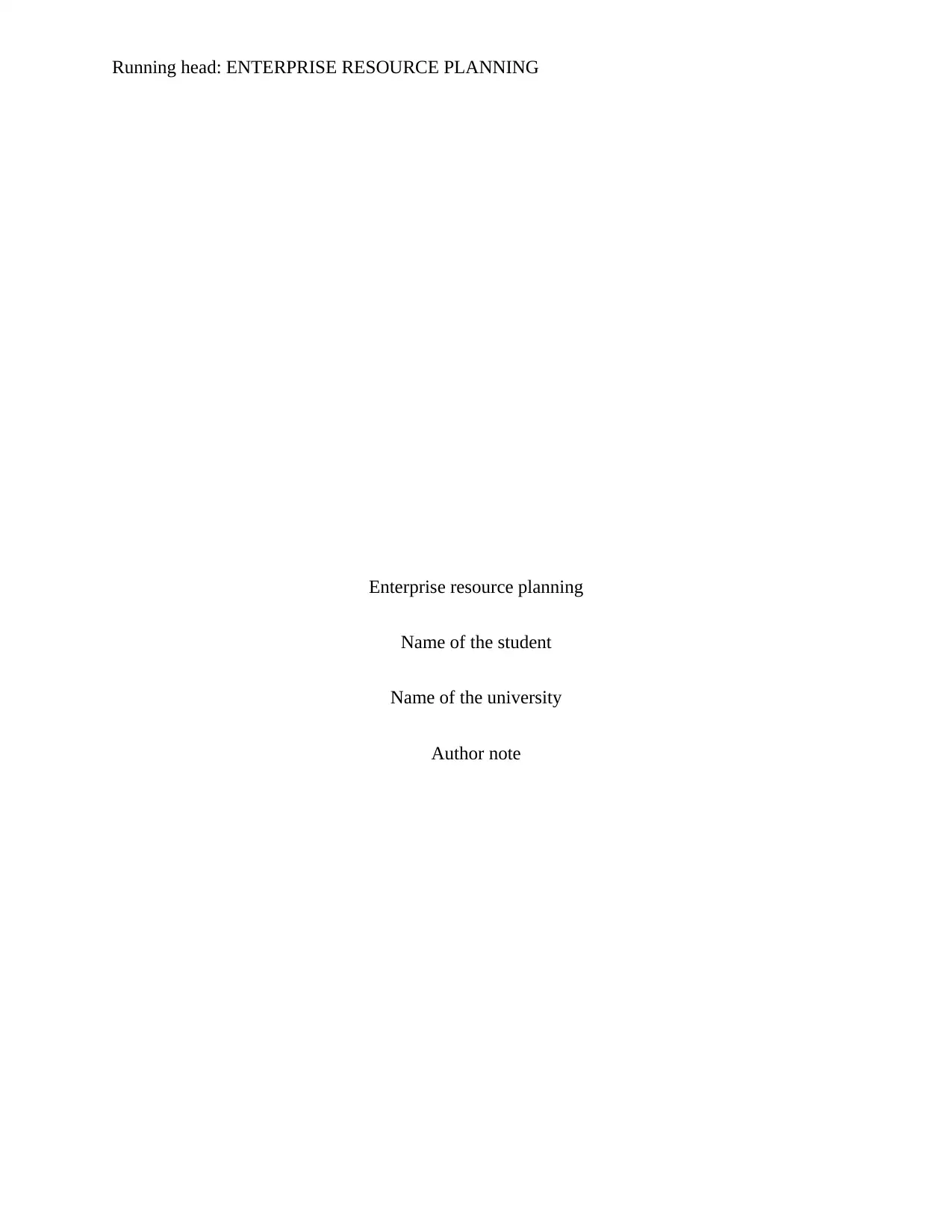
Running head: ENTERPRISE RESOURCE PLANNING
Enterprise resource planning
Name of the student
Name of the university
Author note
Enterprise resource planning
Name of the student
Name of the university
Author note
Secure Best Marks with AI Grader
Need help grading? Try our AI Grader for instant feedback on your assignments.
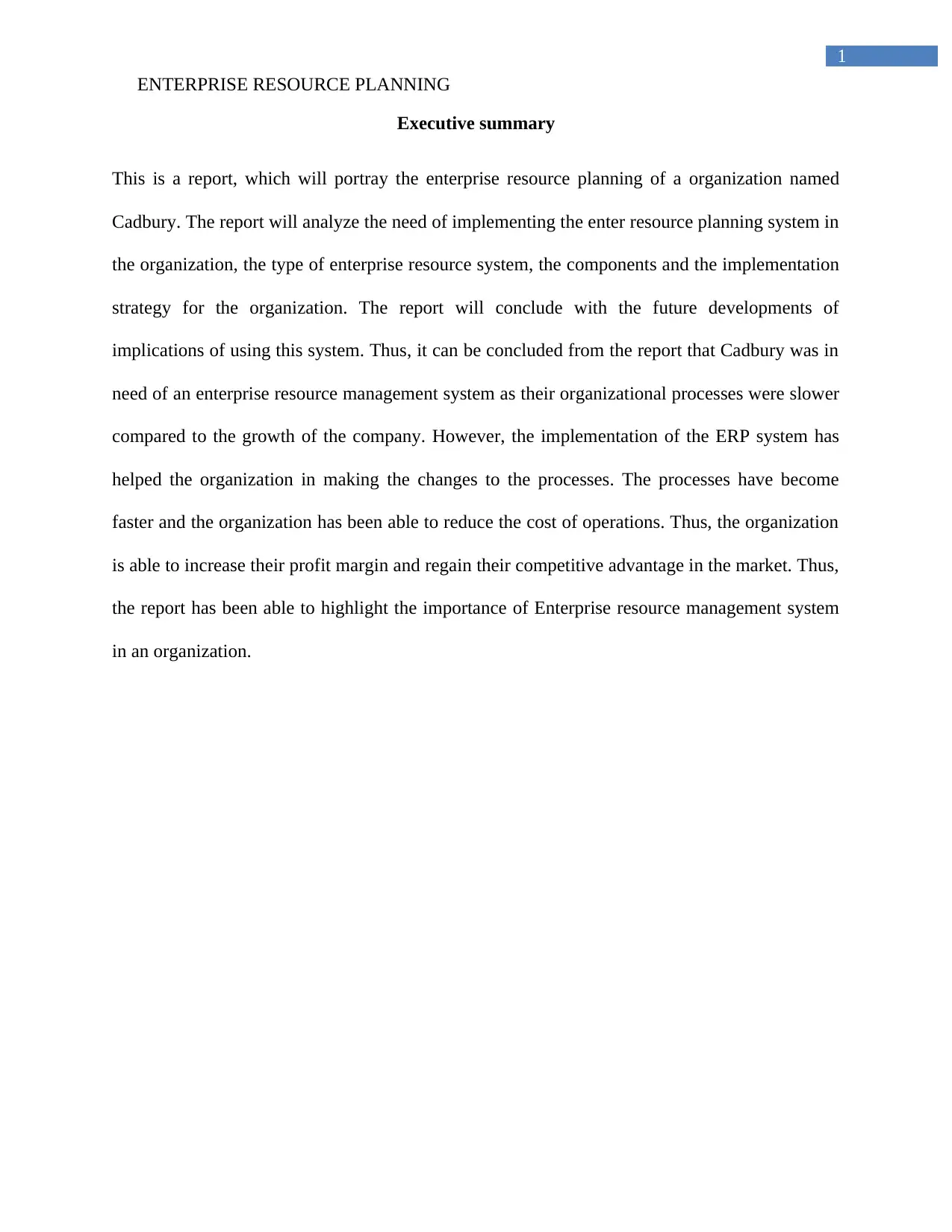
1
ENTERPRISE RESOURCE PLANNING
Executive summary
This is a report, which will portray the enterprise resource planning of a organization named
Cadbury. The report will analyze the need of implementing the enter resource planning system in
the organization, the type of enterprise resource system, the components and the implementation
strategy for the organization. The report will conclude with the future developments of
implications of using this system. Thus, it can be concluded from the report that Cadbury was in
need of an enterprise resource management system as their organizational processes were slower
compared to the growth of the company. However, the implementation of the ERP system has
helped the organization in making the changes to the processes. The processes have become
faster and the organization has been able to reduce the cost of operations. Thus, the organization
is able to increase their profit margin and regain their competitive advantage in the market. Thus,
the report has been able to highlight the importance of Enterprise resource management system
in an organization.
ENTERPRISE RESOURCE PLANNING
Executive summary
This is a report, which will portray the enterprise resource planning of a organization named
Cadbury. The report will analyze the need of implementing the enter resource planning system in
the organization, the type of enterprise resource system, the components and the implementation
strategy for the organization. The report will conclude with the future developments of
implications of using this system. Thus, it can be concluded from the report that Cadbury was in
need of an enterprise resource management system as their organizational processes were slower
compared to the growth of the company. However, the implementation of the ERP system has
helped the organization in making the changes to the processes. The processes have become
faster and the organization has been able to reduce the cost of operations. Thus, the organization
is able to increase their profit margin and regain their competitive advantage in the market. Thus,
the report has been able to highlight the importance of Enterprise resource management system
in an organization.
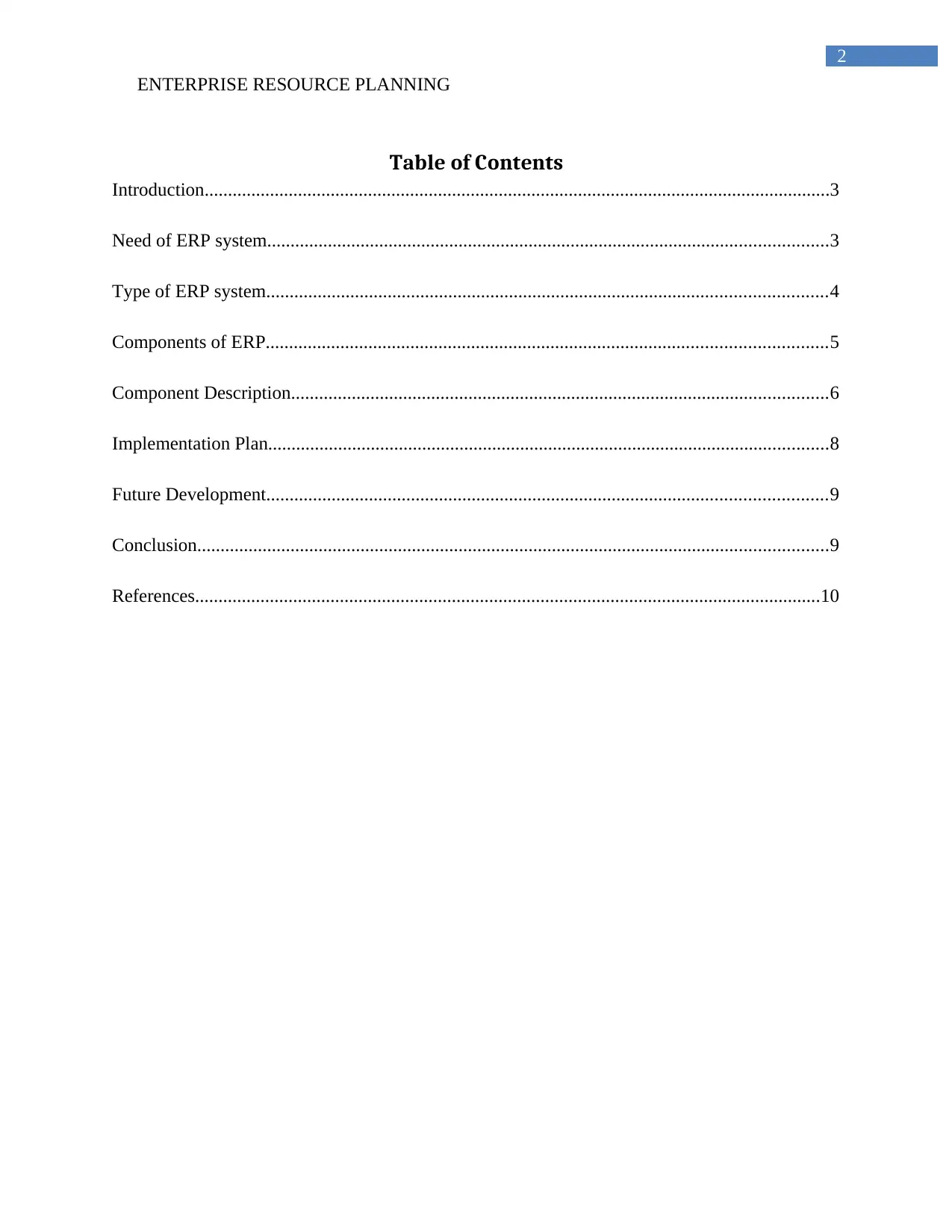
2
ENTERPRISE RESOURCE PLANNING
Table of Contents
Introduction......................................................................................................................................3
Need of ERP system........................................................................................................................3
Type of ERP system........................................................................................................................4
Components of ERP........................................................................................................................5
Component Description...................................................................................................................6
Implementation Plan........................................................................................................................8
Future Development........................................................................................................................9
Conclusion.......................................................................................................................................9
References......................................................................................................................................10
ENTERPRISE RESOURCE PLANNING
Table of Contents
Introduction......................................................................................................................................3
Need of ERP system........................................................................................................................3
Type of ERP system........................................................................................................................4
Components of ERP........................................................................................................................5
Component Description...................................................................................................................6
Implementation Plan........................................................................................................................8
Future Development........................................................................................................................9
Conclusion.......................................................................................................................................9
References......................................................................................................................................10
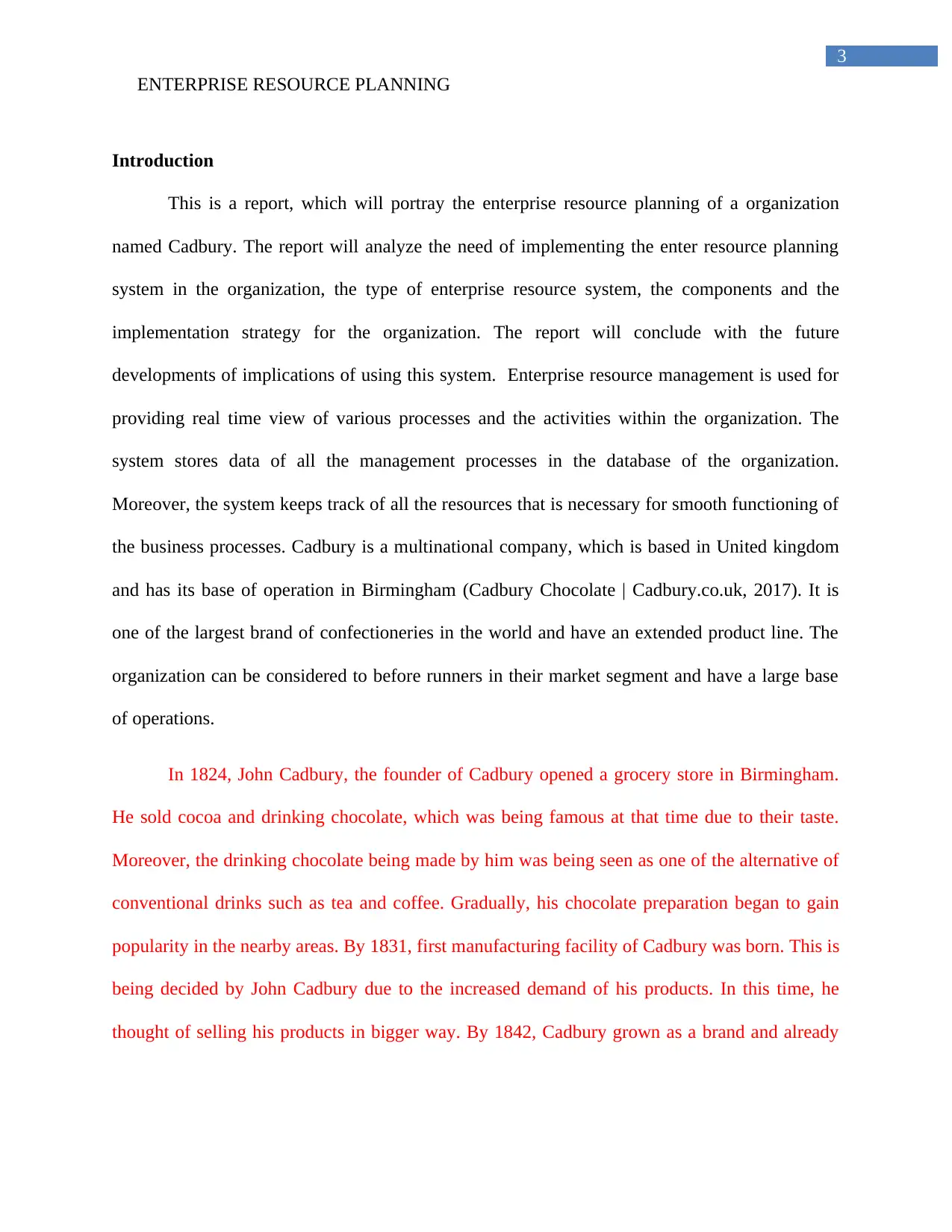
3
ENTERPRISE RESOURCE PLANNING
Introduction
This is a report, which will portray the enterprise resource planning of a organization
named Cadbury. The report will analyze the need of implementing the enter resource planning
system in the organization, the type of enterprise resource system, the components and the
implementation strategy for the organization. The report will conclude with the future
developments of implications of using this system. Enterprise resource management is used for
providing real time view of various processes and the activities within the organization. The
system stores data of all the management processes in the database of the organization.
Moreover, the system keeps track of all the resources that is necessary for smooth functioning of
the business processes. Cadbury is a multinational company, which is based in United kingdom
and has its base of operation in Birmingham (Cadbury Chocolate | Cadbury.co.uk, 2017). It is
one of the largest brand of confectioneries in the world and have an extended product line. The
organization can be considered to before runners in their market segment and have a large base
of operations.
In 1824, John Cadbury, the founder of Cadbury opened a grocery store in Birmingham.
He sold cocoa and drinking chocolate, which was being famous at that time due to their taste.
Moreover, the drinking chocolate being made by him was being seen as one of the alternative of
conventional drinks such as tea and coffee. Gradually, his chocolate preparation began to gain
popularity in the nearby areas. By 1831, first manufacturing facility of Cadbury was born. This is
being decided by John Cadbury due to the increased demand of his products. In this time, he
thought of selling his products in bigger way. By 1842, Cadbury grown as a brand and already
ENTERPRISE RESOURCE PLANNING
Introduction
This is a report, which will portray the enterprise resource planning of a organization
named Cadbury. The report will analyze the need of implementing the enter resource planning
system in the organization, the type of enterprise resource system, the components and the
implementation strategy for the organization. The report will conclude with the future
developments of implications of using this system. Enterprise resource management is used for
providing real time view of various processes and the activities within the organization. The
system stores data of all the management processes in the database of the organization.
Moreover, the system keeps track of all the resources that is necessary for smooth functioning of
the business processes. Cadbury is a multinational company, which is based in United kingdom
and has its base of operation in Birmingham (Cadbury Chocolate | Cadbury.co.uk, 2017). It is
one of the largest brand of confectioneries in the world and have an extended product line. The
organization can be considered to before runners in their market segment and have a large base
of operations.
In 1824, John Cadbury, the founder of Cadbury opened a grocery store in Birmingham.
He sold cocoa and drinking chocolate, which was being famous at that time due to their taste.
Moreover, the drinking chocolate being made by him was being seen as one of the alternative of
conventional drinks such as tea and coffee. Gradually, his chocolate preparation began to gain
popularity in the nearby areas. By 1831, first manufacturing facility of Cadbury was born. This is
being decided by John Cadbury due to the increased demand of his products. In this time, he
thought of selling his products in bigger way. By 1842, Cadbury grown as a brand and already
Secure Best Marks with AI Grader
Need help grading? Try our AI Grader for instant feedback on your assignments.
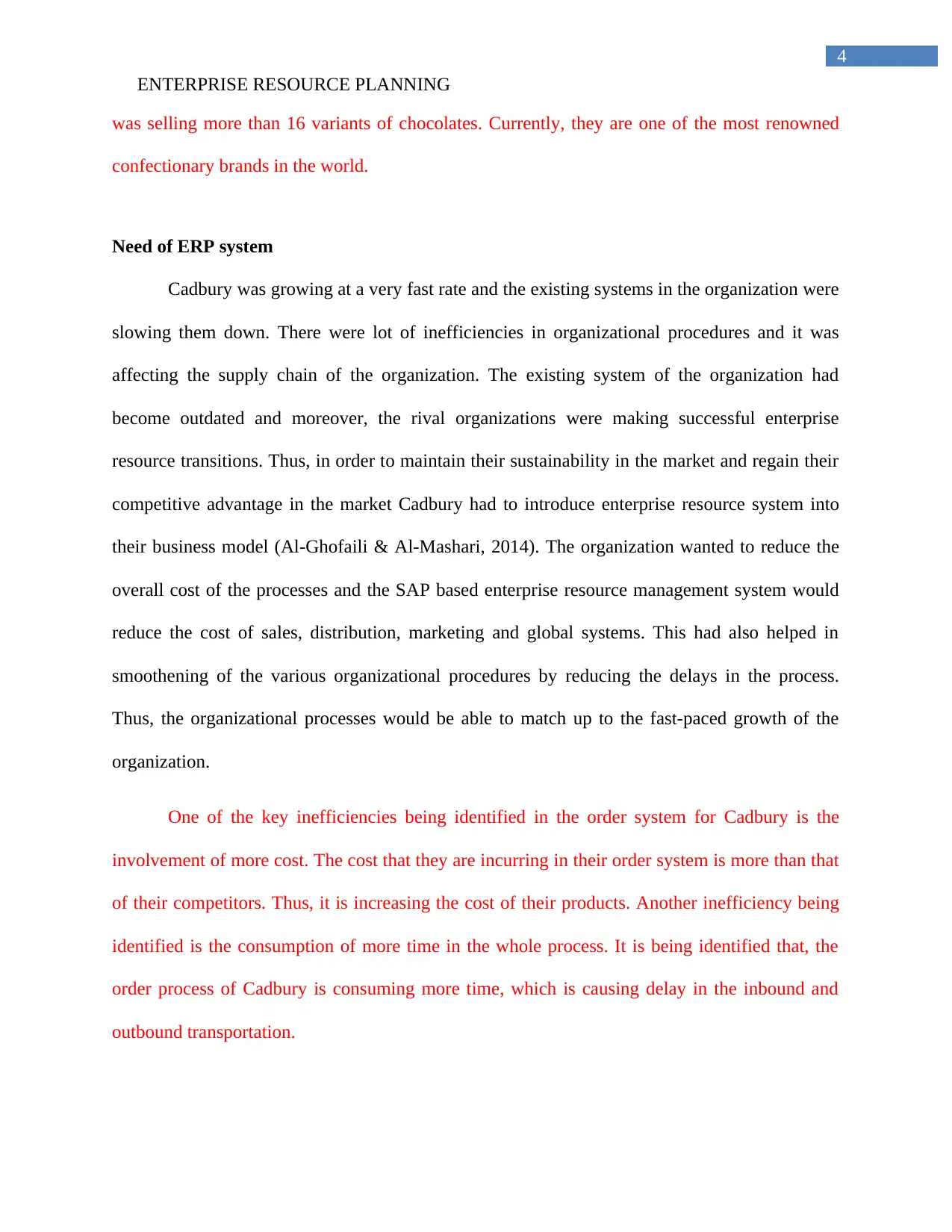
4
ENTERPRISE RESOURCE PLANNING
was selling more than 16 variants of chocolates. Currently, they are one of the most renowned
confectionary brands in the world.
Need of ERP system
Cadbury was growing at a very fast rate and the existing systems in the organization were
slowing them down. There were lot of inefficiencies in organizational procedures and it was
affecting the supply chain of the organization. The existing system of the organization had
become outdated and moreover, the rival organizations were making successful enterprise
resource transitions. Thus, in order to maintain their sustainability in the market and regain their
competitive advantage in the market Cadbury had to introduce enterprise resource system into
their business model (Al-Ghofaili & Al-Mashari, 2014). The organization wanted to reduce the
overall cost of the processes and the SAP based enterprise resource management system would
reduce the cost of sales, distribution, marketing and global systems. This had also helped in
smoothening of the various organizational procedures by reducing the delays in the process.
Thus, the organizational processes would be able to match up to the fast-paced growth of the
organization.
One of the key inefficiencies being identified in the order system for Cadbury is the
involvement of more cost. The cost that they are incurring in their order system is more than that
of their competitors. Thus, it is increasing the cost of their products. Another inefficiency being
identified is the consumption of more time in the whole process. It is being identified that, the
order process of Cadbury is consuming more time, which is causing delay in the inbound and
outbound transportation.
ENTERPRISE RESOURCE PLANNING
was selling more than 16 variants of chocolates. Currently, they are one of the most renowned
confectionary brands in the world.
Need of ERP system
Cadbury was growing at a very fast rate and the existing systems in the organization were
slowing them down. There were lot of inefficiencies in organizational procedures and it was
affecting the supply chain of the organization. The existing system of the organization had
become outdated and moreover, the rival organizations were making successful enterprise
resource transitions. Thus, in order to maintain their sustainability in the market and regain their
competitive advantage in the market Cadbury had to introduce enterprise resource system into
their business model (Al-Ghofaili & Al-Mashari, 2014). The organization wanted to reduce the
overall cost of the processes and the SAP based enterprise resource management system would
reduce the cost of sales, distribution, marketing and global systems. This had also helped in
smoothening of the various organizational procedures by reducing the delays in the process.
Thus, the organizational processes would be able to match up to the fast-paced growth of the
organization.
One of the key inefficiencies being identified in the order system for Cadbury is the
involvement of more cost. The cost that they are incurring in their order system is more than that
of their competitors. Thus, it is increasing the cost of their products. Another inefficiency being
identified is the consumption of more time in the whole process. It is being identified that, the
order process of Cadbury is consuming more time, which is causing delay in the inbound and
outbound transportation.
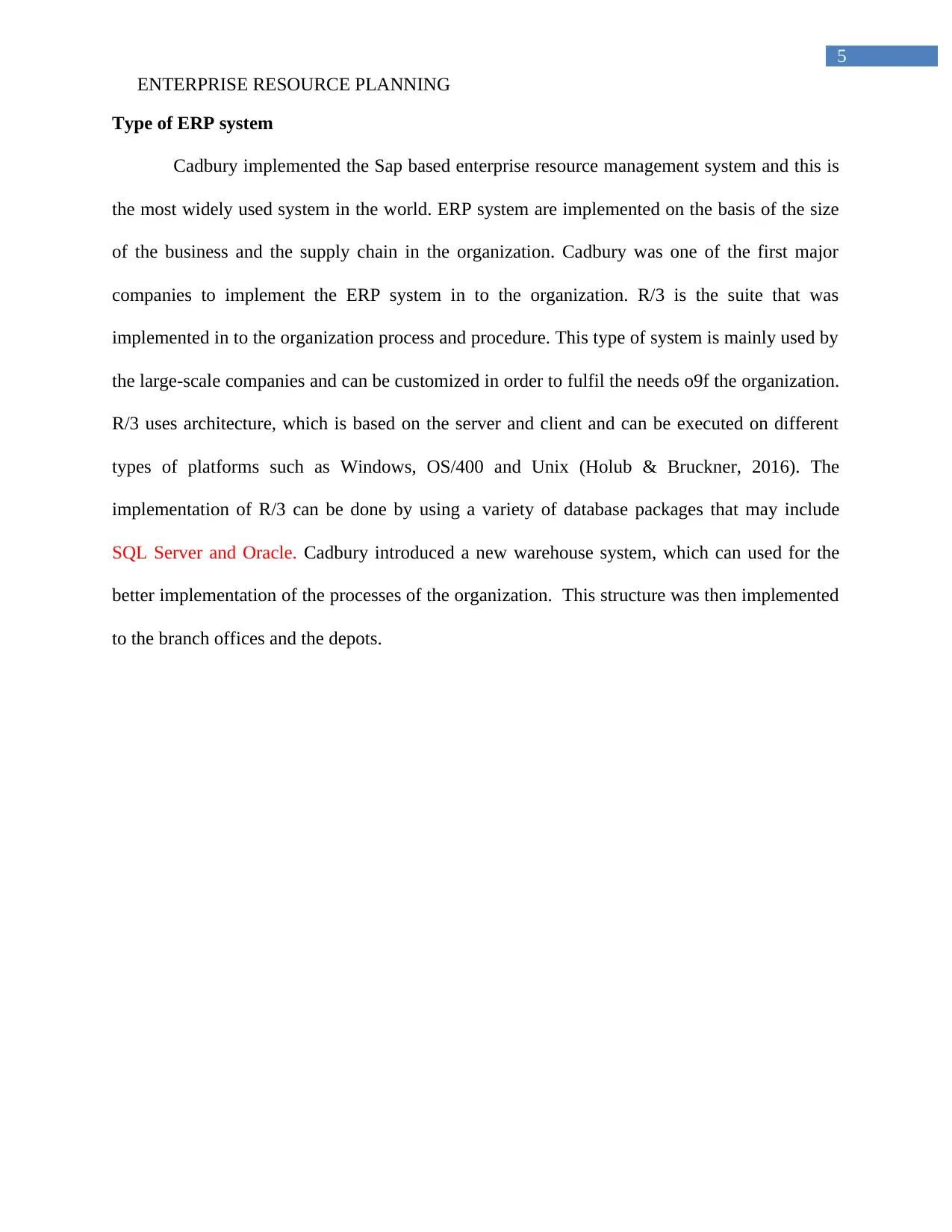
5
ENTERPRISE RESOURCE PLANNING
Type of ERP system
Cadbury implemented the Sap based enterprise resource management system and this is
the most widely used system in the world. ERP system are implemented on the basis of the size
of the business and the supply chain in the organization. Cadbury was one of the first major
companies to implement the ERP system in to the organization. R/3 is the suite that was
implemented in to the organization process and procedure. This type of system is mainly used by
the large-scale companies and can be customized in order to fulfil the needs o9f the organization.
R/3 uses architecture, which is based on the server and client and can be executed on different
types of platforms such as Windows, OS/400 and Unix (Holub & Bruckner, 2016). The
implementation of R/3 can be done by using a variety of database packages that may include
SQL Server and Oracle. Cadbury introduced a new warehouse system, which can used for the
better implementation of the processes of the organization. This structure was then implemented
to the branch offices and the depots.
ENTERPRISE RESOURCE PLANNING
Type of ERP system
Cadbury implemented the Sap based enterprise resource management system and this is
the most widely used system in the world. ERP system are implemented on the basis of the size
of the business and the supply chain in the organization. Cadbury was one of the first major
companies to implement the ERP system in to the organization. R/3 is the suite that was
implemented in to the organization process and procedure. This type of system is mainly used by
the large-scale companies and can be customized in order to fulfil the needs o9f the organization.
R/3 uses architecture, which is based on the server and client and can be executed on different
types of platforms such as Windows, OS/400 and Unix (Holub & Bruckner, 2016). The
implementation of R/3 can be done by using a variety of database packages that may include
SQL Server and Oracle. Cadbury introduced a new warehouse system, which can used for the
better implementation of the processes of the organization. This structure was then implemented
to the branch offices and the depots.
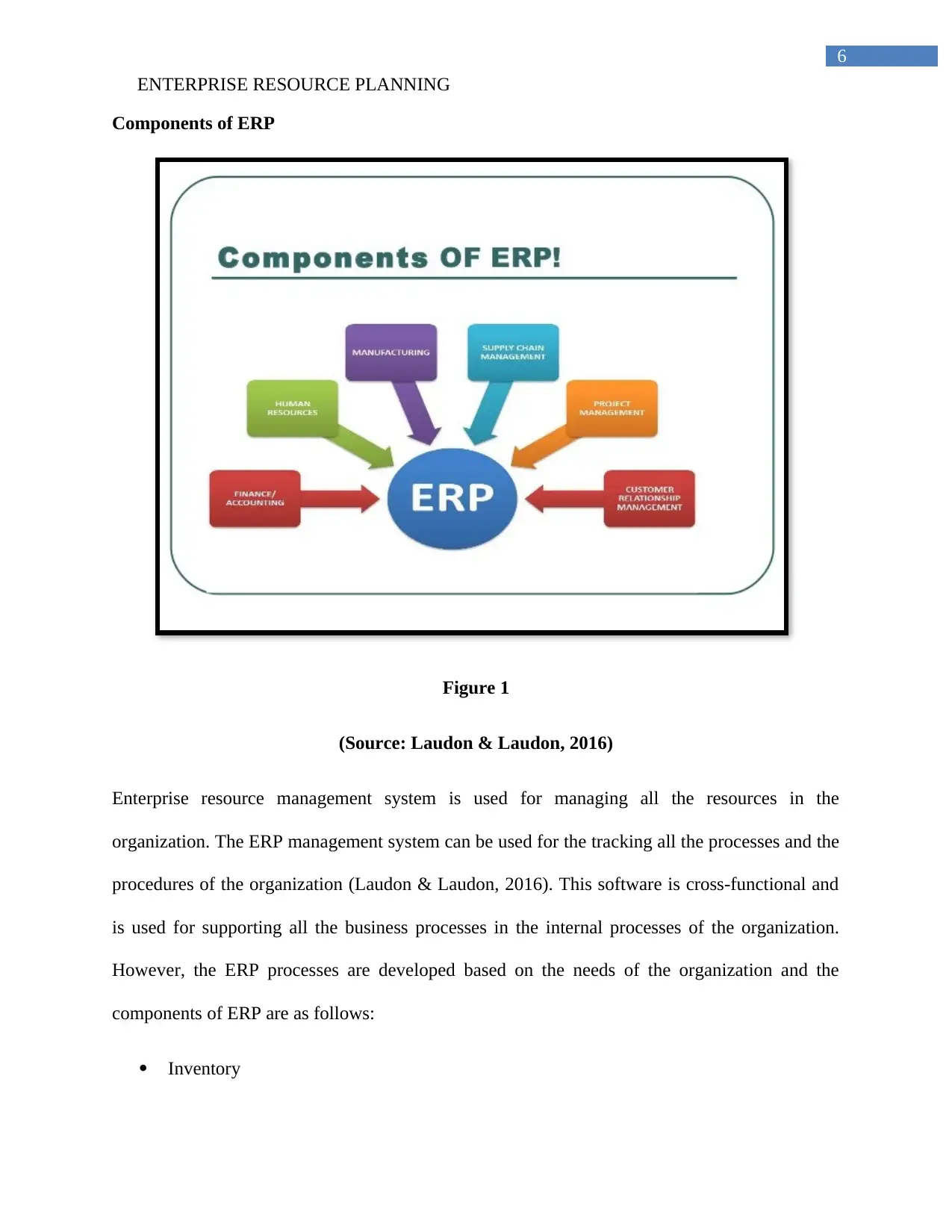
6
ENTERPRISE RESOURCE PLANNING
Components of ERP
Figure 1
(Source: Laudon & Laudon, 2016)
Enterprise resource management system is used for managing all the resources in the
organization. The ERP management system can be used for the tracking all the processes and the
procedures of the organization (Laudon & Laudon, 2016). This software is cross-functional and
is used for supporting all the business processes in the internal processes of the organization.
However, the ERP processes are developed based on the needs of the organization and the
components of ERP are as follows:
Inventory
ENTERPRISE RESOURCE PLANNING
Components of ERP
Figure 1
(Source: Laudon & Laudon, 2016)
Enterprise resource management system is used for managing all the resources in the
organization. The ERP management system can be used for the tracking all the processes and the
procedures of the organization (Laudon & Laudon, 2016). This software is cross-functional and
is used for supporting all the business processes in the internal processes of the organization.
However, the ERP processes are developed based on the needs of the organization and the
components of ERP are as follows:
Inventory
Paraphrase This Document
Need a fresh take? Get an instant paraphrase of this document with our AI Paraphraser
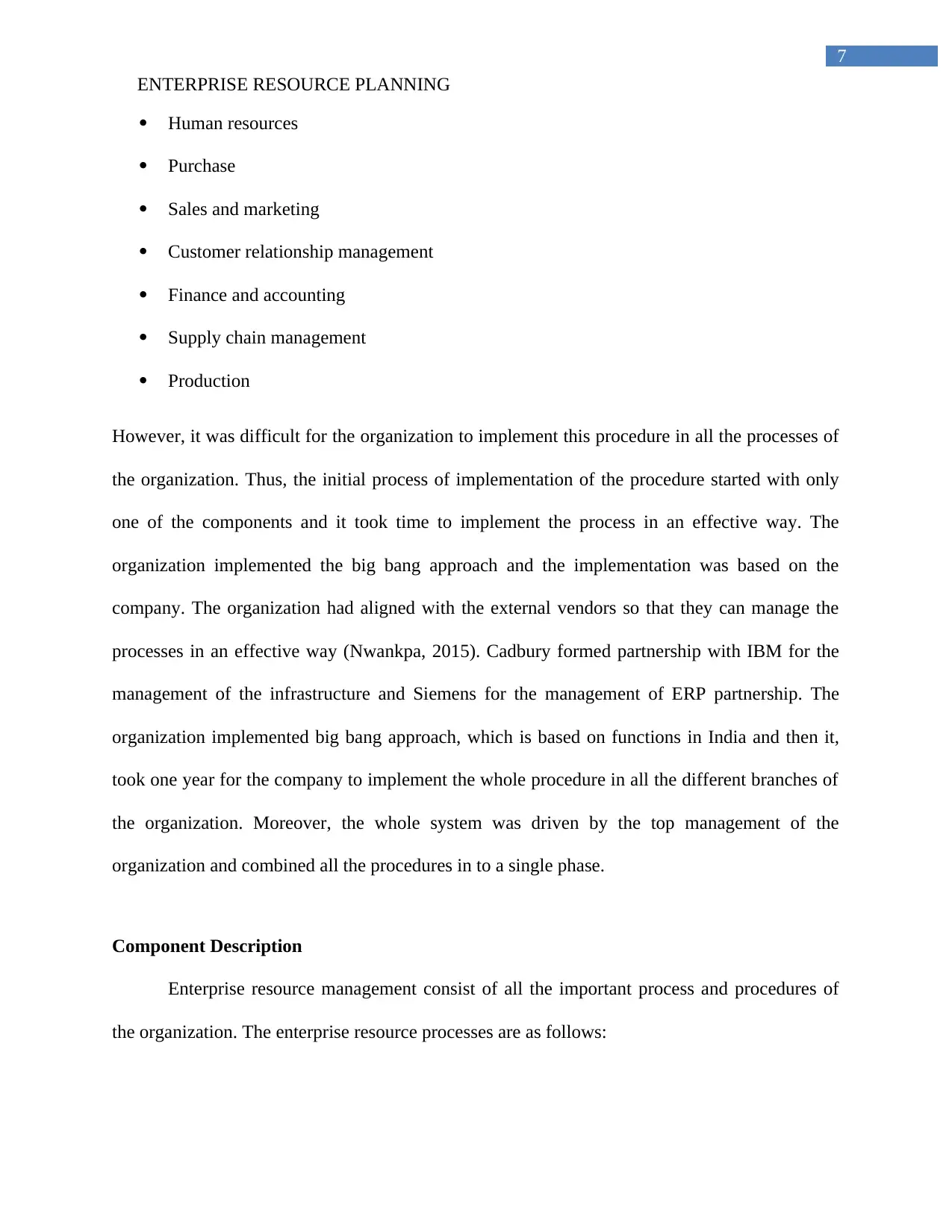
7
ENTERPRISE RESOURCE PLANNING
Human resources
Purchase
Sales and marketing
Customer relationship management
Finance and accounting
Supply chain management
Production
However, it was difficult for the organization to implement this procedure in all the processes of
the organization. Thus, the initial process of implementation of the procedure started with only
one of the components and it took time to implement the process in an effective way. The
organization implemented the big bang approach and the implementation was based on the
company. The organization had aligned with the external vendors so that they can manage the
processes in an effective way (Nwankpa, 2015). Cadbury formed partnership with IBM for the
management of the infrastructure and Siemens for the management of ERP partnership. The
organization implemented big bang approach, which is based on functions in India and then it,
took one year for the company to implement the whole procedure in all the different branches of
the organization. Moreover, the whole system was driven by the top management of the
organization and combined all the procedures in to a single phase.
Component Description
Enterprise resource management consist of all the important process and procedures of
the organization. The enterprise resource processes are as follows:
ENTERPRISE RESOURCE PLANNING
Human resources
Purchase
Sales and marketing
Customer relationship management
Finance and accounting
Supply chain management
Production
However, it was difficult for the organization to implement this procedure in all the processes of
the organization. Thus, the initial process of implementation of the procedure started with only
one of the components and it took time to implement the process in an effective way. The
organization implemented the big bang approach and the implementation was based on the
company. The organization had aligned with the external vendors so that they can manage the
processes in an effective way (Nwankpa, 2015). Cadbury formed partnership with IBM for the
management of the infrastructure and Siemens for the management of ERP partnership. The
organization implemented big bang approach, which is based on functions in India and then it,
took one year for the company to implement the whole procedure in all the different branches of
the organization. Moreover, the whole system was driven by the top management of the
organization and combined all the procedures in to a single phase.
Component Description
Enterprise resource management consist of all the important process and procedures of
the organization. The enterprise resource processes are as follows:
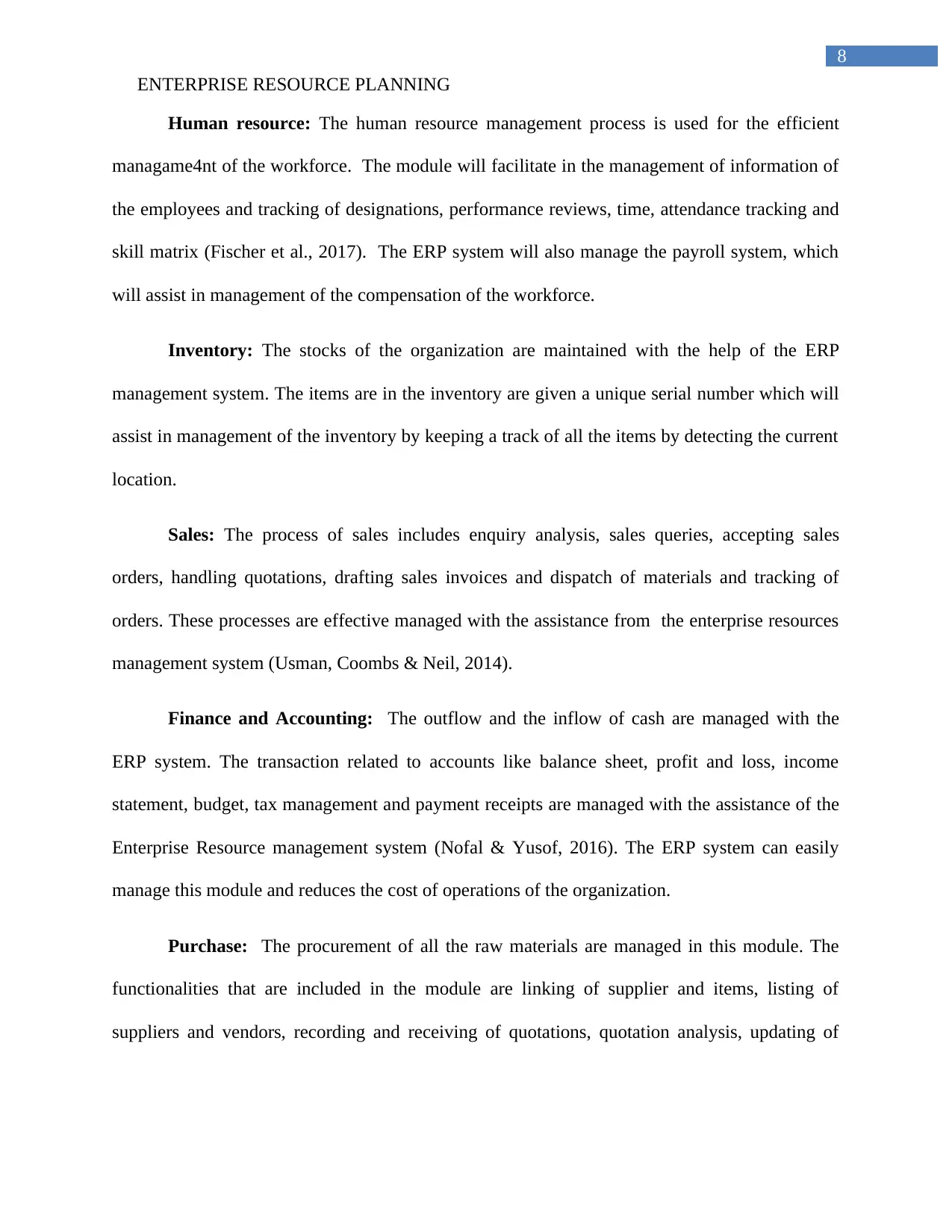
8
ENTERPRISE RESOURCE PLANNING
Human resource: The human resource management process is used for the efficient
managame4nt of the workforce. The module will facilitate in the management of information of
the employees and tracking of designations, performance reviews, time, attendance tracking and
skill matrix (Fischer et al., 2017). The ERP system will also manage the payroll system, which
will assist in management of the compensation of the workforce.
Inventory: The stocks of the organization are maintained with the help of the ERP
management system. The items are in the inventory are given a unique serial number which will
assist in management of the inventory by keeping a track of all the items by detecting the current
location.
Sales: The process of sales includes enquiry analysis, sales queries, accepting sales
orders, handling quotations, drafting sales invoices and dispatch of materials and tracking of
orders. These processes are effective managed with the assistance from the enterprise resources
management system (Usman, Coombs & Neil, 2014).
Finance and Accounting: The outflow and the inflow of cash are managed with the
ERP system. The transaction related to accounts like balance sheet, profit and loss, income
statement, budget, tax management and payment receipts are managed with the assistance of the
Enterprise Resource management system (Nofal & Yusof, 2016). The ERP system can easily
manage this module and reduces the cost of operations of the organization.
Purchase: The procurement of all the raw materials are managed in this module. The
functionalities that are included in the module are linking of supplier and items, listing of
suppliers and vendors, recording and receiving of quotations, quotation analysis, updating of
ENTERPRISE RESOURCE PLANNING
Human resource: The human resource management process is used for the efficient
managame4nt of the workforce. The module will facilitate in the management of information of
the employees and tracking of designations, performance reviews, time, attendance tracking and
skill matrix (Fischer et al., 2017). The ERP system will also manage the payroll system, which
will assist in management of the compensation of the workforce.
Inventory: The stocks of the organization are maintained with the help of the ERP
management system. The items are in the inventory are given a unique serial number which will
assist in management of the inventory by keeping a track of all the items by detecting the current
location.
Sales: The process of sales includes enquiry analysis, sales queries, accepting sales
orders, handling quotations, drafting sales invoices and dispatch of materials and tracking of
orders. These processes are effective managed with the assistance from the enterprise resources
management system (Usman, Coombs & Neil, 2014).
Finance and Accounting: The outflow and the inflow of cash are managed with the
ERP system. The transaction related to accounts like balance sheet, profit and loss, income
statement, budget, tax management and payment receipts are managed with the assistance of the
Enterprise Resource management system (Nofal & Yusof, 2016). The ERP system can easily
manage this module and reduces the cost of operations of the organization.
Purchase: The procurement of all the raw materials are managed in this module. The
functionalities that are included in the module are linking of supplier and items, listing of
suppliers and vendors, recording and receiving of quotations, quotation analysis, updating of
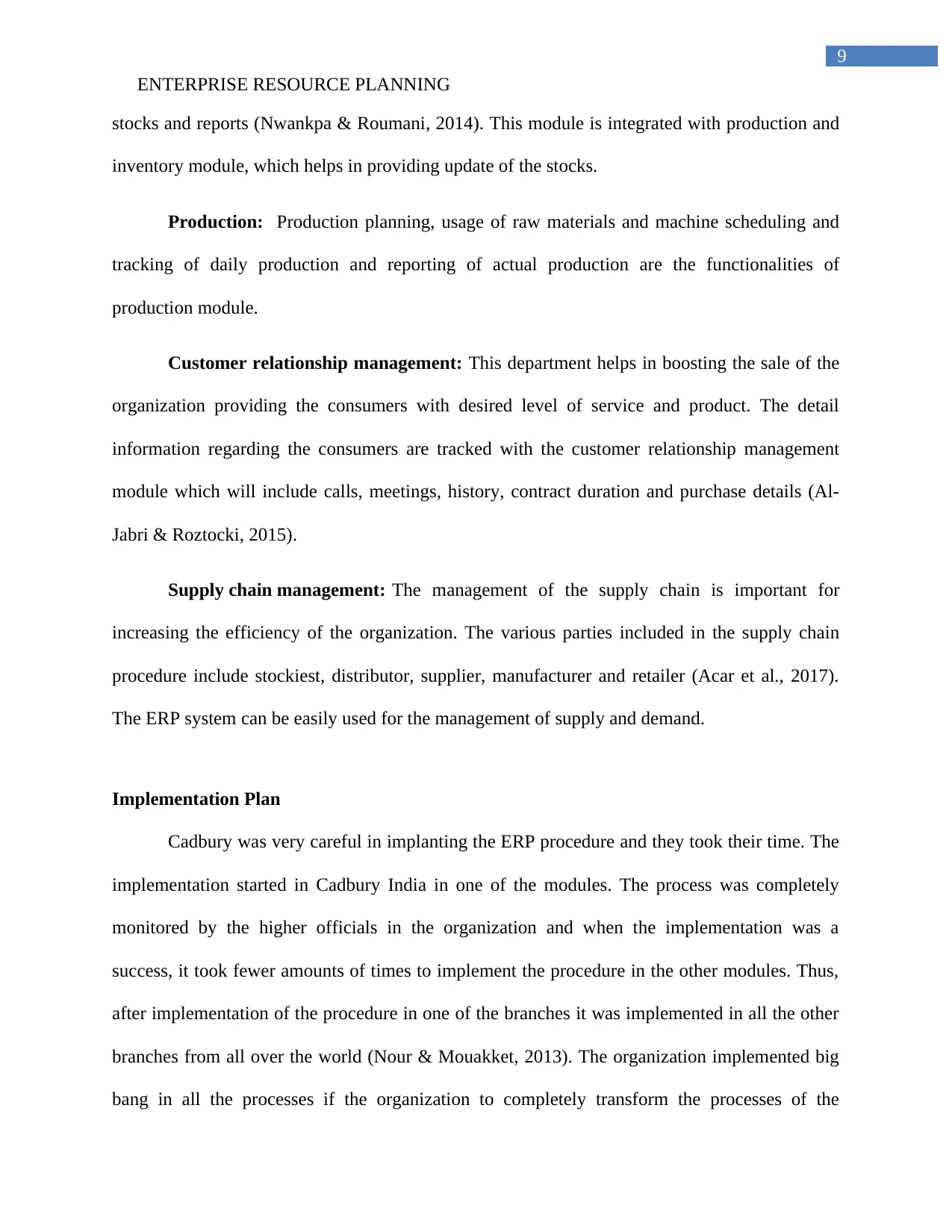
9
ENTERPRISE RESOURCE PLANNING
stocks and reports (Nwankpa & Roumani, 2014). This module is integrated with production and
inventory module, which helps in providing update of the stocks.
Production: Production planning, usage of raw materials and machine scheduling and
tracking of daily production and reporting of actual production are the functionalities of
production module.
Customer relationship management: This department helps in boosting the sale of the
organization providing the consumers with desired level of service and product. The detail
information regarding the consumers are tracked with the customer relationship management
module which will include calls, meetings, history, contract duration and purchase details (Al-
Jabri & Roztocki, 2015).
Supply chain management: The management of the supply chain is important for
increasing the efficiency of the organization. The various parties included in the supply chain
procedure include stockiest, distributor, supplier, manufacturer and retailer (Acar et al., 2017).
The ERP system can be easily used for the management of supply and demand.
Implementation Plan
Cadbury was very careful in implanting the ERP procedure and they took their time. The
implementation started in Cadbury India in one of the modules. The process was completely
monitored by the higher officials in the organization and when the implementation was a
success, it took fewer amounts of times to implement the procedure in the other modules. Thus,
after implementation of the procedure in one of the branches it was implemented in all the other
branches from all over the world (Nour & Mouakket, 2013). The organization implemented big
bang in all the processes if the organization to completely transform the processes of the
ENTERPRISE RESOURCE PLANNING
stocks and reports (Nwankpa & Roumani, 2014). This module is integrated with production and
inventory module, which helps in providing update of the stocks.
Production: Production planning, usage of raw materials and machine scheduling and
tracking of daily production and reporting of actual production are the functionalities of
production module.
Customer relationship management: This department helps in boosting the sale of the
organization providing the consumers with desired level of service and product. The detail
information regarding the consumers are tracked with the customer relationship management
module which will include calls, meetings, history, contract duration and purchase details (Al-
Jabri & Roztocki, 2015).
Supply chain management: The management of the supply chain is important for
increasing the efficiency of the organization. The various parties included in the supply chain
procedure include stockiest, distributor, supplier, manufacturer and retailer (Acar et al., 2017).
The ERP system can be easily used for the management of supply and demand.
Implementation Plan
Cadbury was very careful in implanting the ERP procedure and they took their time. The
implementation started in Cadbury India in one of the modules. The process was completely
monitored by the higher officials in the organization and when the implementation was a
success, it took fewer amounts of times to implement the procedure in the other modules. Thus,
after implementation of the procedure in one of the branches it was implemented in all the other
branches from all over the world (Nour & Mouakket, 2013). The organization implemented big
bang in all the processes if the organization to completely transform the processes of the
Secure Best Marks with AI Grader
Need help grading? Try our AI Grader for instant feedback on your assignments.
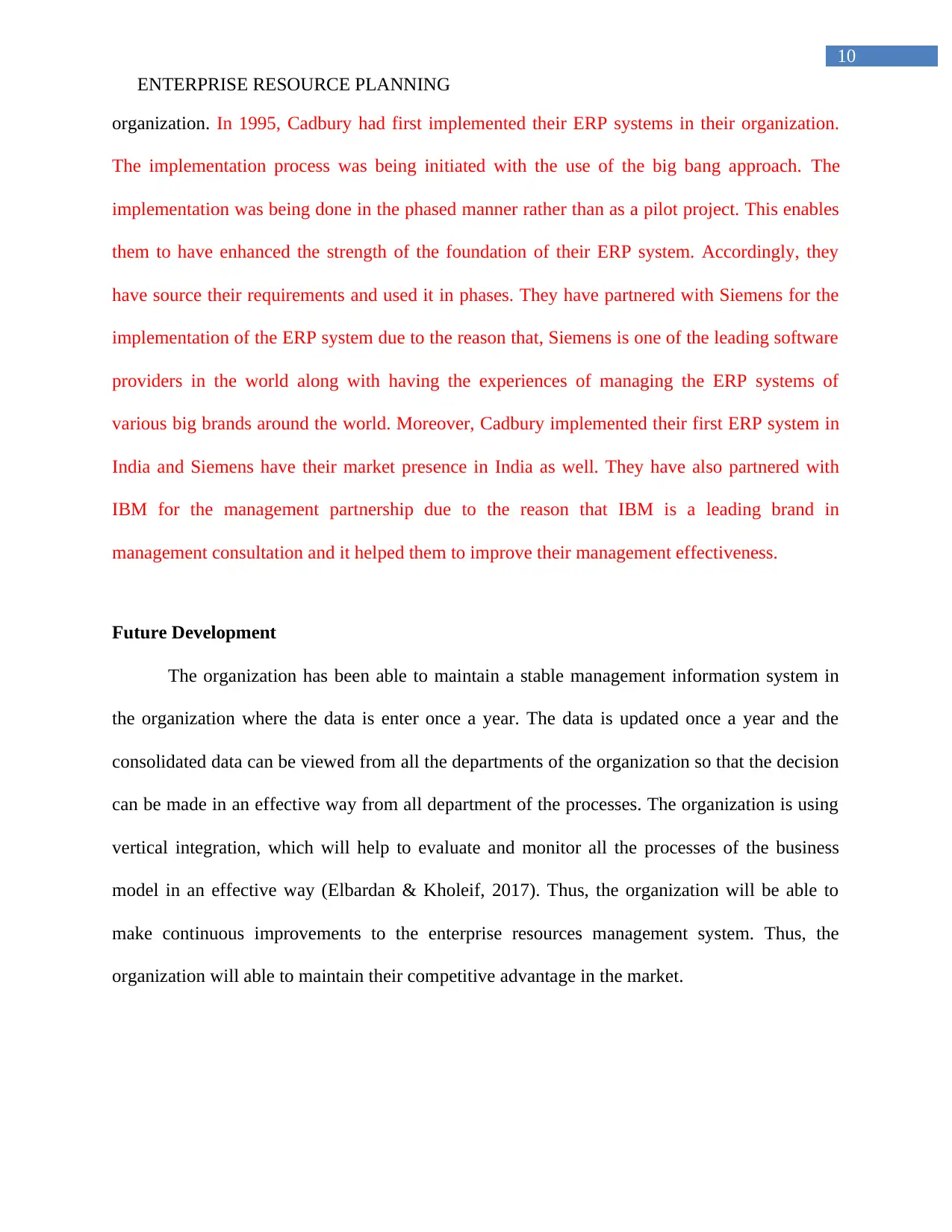
10
ENTERPRISE RESOURCE PLANNING
organization. In 1995, Cadbury had first implemented their ERP systems in their organization.
The implementation process was being initiated with the use of the big bang approach. The
implementation was being done in the phased manner rather than as a pilot project. This enables
them to have enhanced the strength of the foundation of their ERP system. Accordingly, they
have source their requirements and used it in phases. They have partnered with Siemens for the
implementation of the ERP system due to the reason that, Siemens is one of the leading software
providers in the world along with having the experiences of managing the ERP systems of
various big brands around the world. Moreover, Cadbury implemented their first ERP system in
India and Siemens have their market presence in India as well. They have also partnered with
IBM for the management partnership due to the reason that IBM is a leading brand in
management consultation and it helped them to improve their management effectiveness.
Future Development
The organization has been able to maintain a stable management information system in
the organization where the data is enter once a year. The data is updated once a year and the
consolidated data can be viewed from all the departments of the organization so that the decision
can be made in an effective way from all department of the processes. The organization is using
vertical integration, which will help to evaluate and monitor all the processes of the business
model in an effective way (Elbardan & Kholeif, 2017). Thus, the organization will be able to
make continuous improvements to the enterprise resources management system. Thus, the
organization will able to maintain their competitive advantage in the market.
ENTERPRISE RESOURCE PLANNING
organization. In 1995, Cadbury had first implemented their ERP systems in their organization.
The implementation process was being initiated with the use of the big bang approach. The
implementation was being done in the phased manner rather than as a pilot project. This enables
them to have enhanced the strength of the foundation of their ERP system. Accordingly, they
have source their requirements and used it in phases. They have partnered with Siemens for the
implementation of the ERP system due to the reason that, Siemens is one of the leading software
providers in the world along with having the experiences of managing the ERP systems of
various big brands around the world. Moreover, Cadbury implemented their first ERP system in
India and Siemens have their market presence in India as well. They have also partnered with
IBM for the management partnership due to the reason that IBM is a leading brand in
management consultation and it helped them to improve their management effectiveness.
Future Development
The organization has been able to maintain a stable management information system in
the organization where the data is enter once a year. The data is updated once a year and the
consolidated data can be viewed from all the departments of the organization so that the decision
can be made in an effective way from all department of the processes. The organization is using
vertical integration, which will help to evaluate and monitor all the processes of the business
model in an effective way (Elbardan & Kholeif, 2017). Thus, the organization will be able to
make continuous improvements to the enterprise resources management system. Thus, the
organization will able to maintain their competitive advantage in the market.
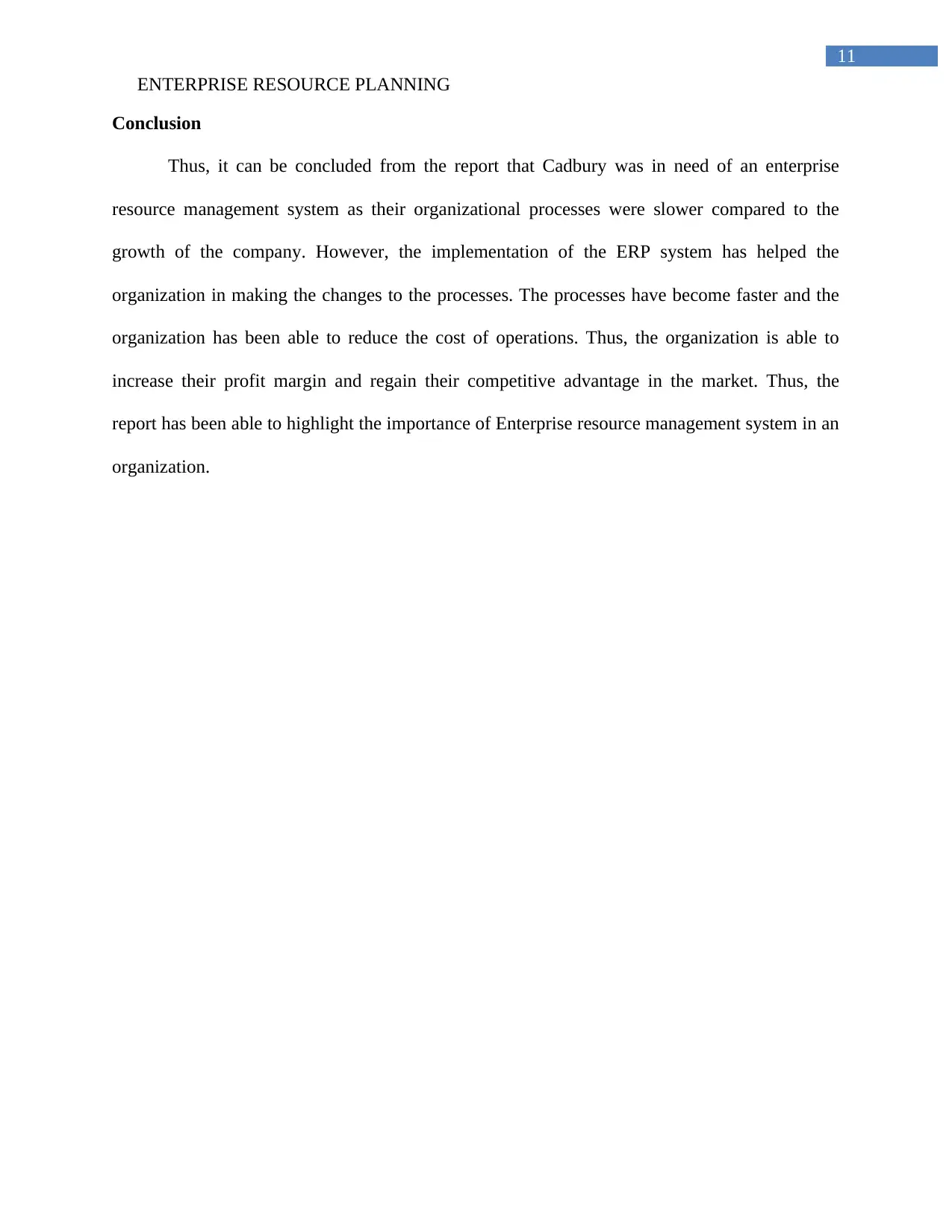
11
ENTERPRISE RESOURCE PLANNING
Conclusion
Thus, it can be concluded from the report that Cadbury was in need of an enterprise
resource management system as their organizational processes were slower compared to the
growth of the company. However, the implementation of the ERP system has helped the
organization in making the changes to the processes. The processes have become faster and the
organization has been able to reduce the cost of operations. Thus, the organization is able to
increase their profit margin and regain their competitive advantage in the market. Thus, the
report has been able to highlight the importance of Enterprise resource management system in an
organization.
ENTERPRISE RESOURCE PLANNING
Conclusion
Thus, it can be concluded from the report that Cadbury was in need of an enterprise
resource management system as their organizational processes were slower compared to the
growth of the company. However, the implementation of the ERP system has helped the
organization in making the changes to the processes. The processes have become faster and the
organization has been able to reduce the cost of operations. Thus, the organization is able to
increase their profit margin and regain their competitive advantage in the market. Thus, the
report has been able to highlight the importance of Enterprise resource management system in an
organization.
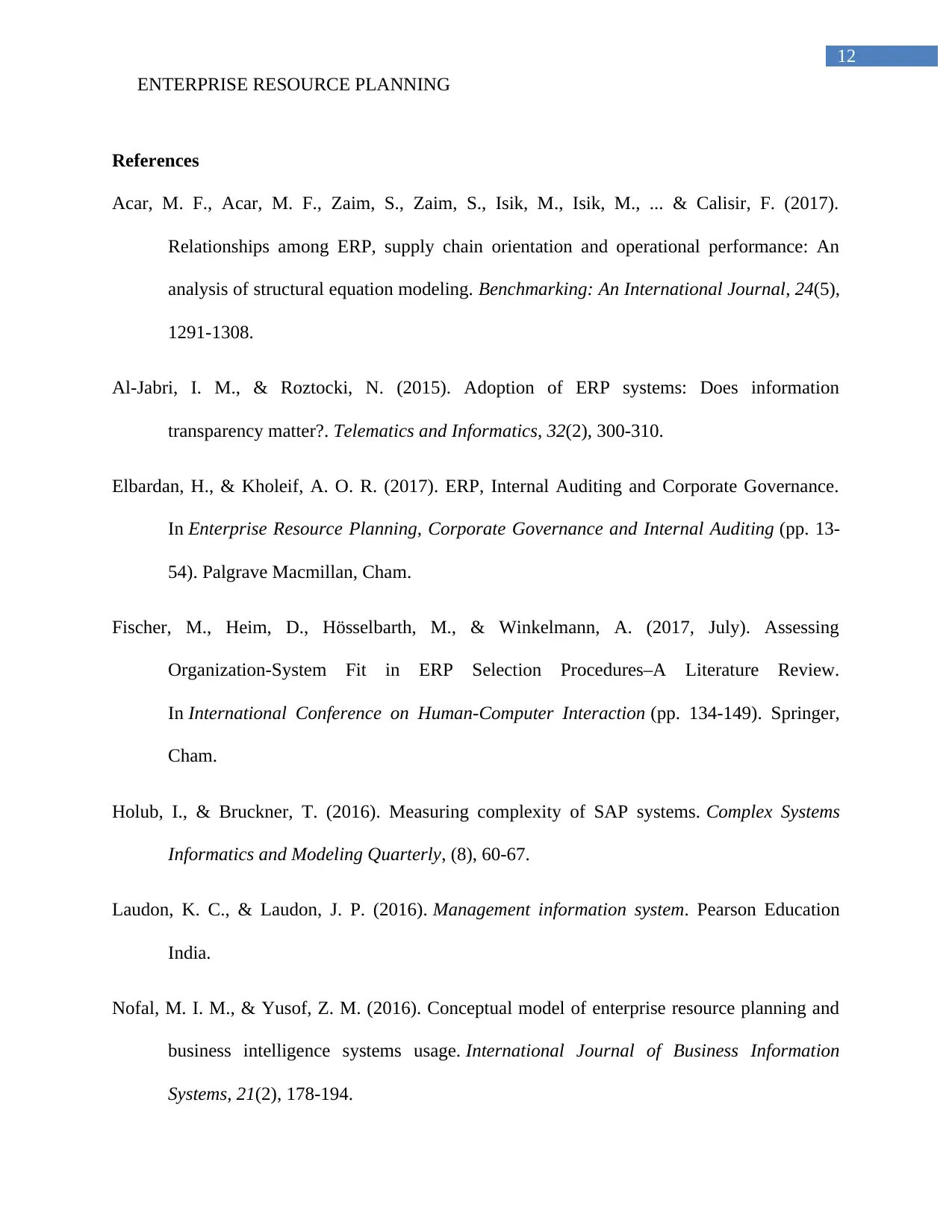
12
ENTERPRISE RESOURCE PLANNING
References
Acar, M. F., Acar, M. F., Zaim, S., Zaim, S., Isik, M., Isik, M., ... & Calisir, F. (2017).
Relationships among ERP, supply chain orientation and operational performance: An
analysis of structural equation modeling. Benchmarking: An International Journal, 24(5),
1291-1308.
Al-Jabri, I. M., & Roztocki, N. (2015). Adoption of ERP systems: Does information
transparency matter?. Telematics and Informatics, 32(2), 300-310.
Elbardan, H., & Kholeif, A. O. R. (2017). ERP, Internal Auditing and Corporate Governance.
In Enterprise Resource Planning, Corporate Governance and Internal Auditing (pp. 13-
54). Palgrave Macmillan, Cham.
Fischer, M., Heim, D., Hösselbarth, M., & Winkelmann, A. (2017, July). Assessing
Organization-System Fit in ERP Selection Procedures–A Literature Review.
In International Conference on Human-Computer Interaction (pp. 134-149). Springer,
Cham.
Holub, I., & Bruckner, T. (2016). Measuring complexity of SAP systems. Complex Systems
Informatics and Modeling Quarterly, (8), 60-67.
Laudon, K. C., & Laudon, J. P. (2016). Management information system. Pearson Education
India.
Nofal, M. I. M., & Yusof, Z. M. (2016). Conceptual model of enterprise resource planning and
business intelligence systems usage. International Journal of Business Information
Systems, 21(2), 178-194.
ENTERPRISE RESOURCE PLANNING
References
Acar, M. F., Acar, M. F., Zaim, S., Zaim, S., Isik, M., Isik, M., ... & Calisir, F. (2017).
Relationships among ERP, supply chain orientation and operational performance: An
analysis of structural equation modeling. Benchmarking: An International Journal, 24(5),
1291-1308.
Al-Jabri, I. M., & Roztocki, N. (2015). Adoption of ERP systems: Does information
transparency matter?. Telematics and Informatics, 32(2), 300-310.
Elbardan, H., & Kholeif, A. O. R. (2017). ERP, Internal Auditing and Corporate Governance.
In Enterprise Resource Planning, Corporate Governance and Internal Auditing (pp. 13-
54). Palgrave Macmillan, Cham.
Fischer, M., Heim, D., Hösselbarth, M., & Winkelmann, A. (2017, July). Assessing
Organization-System Fit in ERP Selection Procedures–A Literature Review.
In International Conference on Human-Computer Interaction (pp. 134-149). Springer,
Cham.
Holub, I., & Bruckner, T. (2016). Measuring complexity of SAP systems. Complex Systems
Informatics and Modeling Quarterly, (8), 60-67.
Laudon, K. C., & Laudon, J. P. (2016). Management information system. Pearson Education
India.
Nofal, M. I. M., & Yusof, Z. M. (2016). Conceptual model of enterprise resource planning and
business intelligence systems usage. International Journal of Business Information
Systems, 21(2), 178-194.
Paraphrase This Document
Need a fresh take? Get an instant paraphrase of this document with our AI Paraphraser
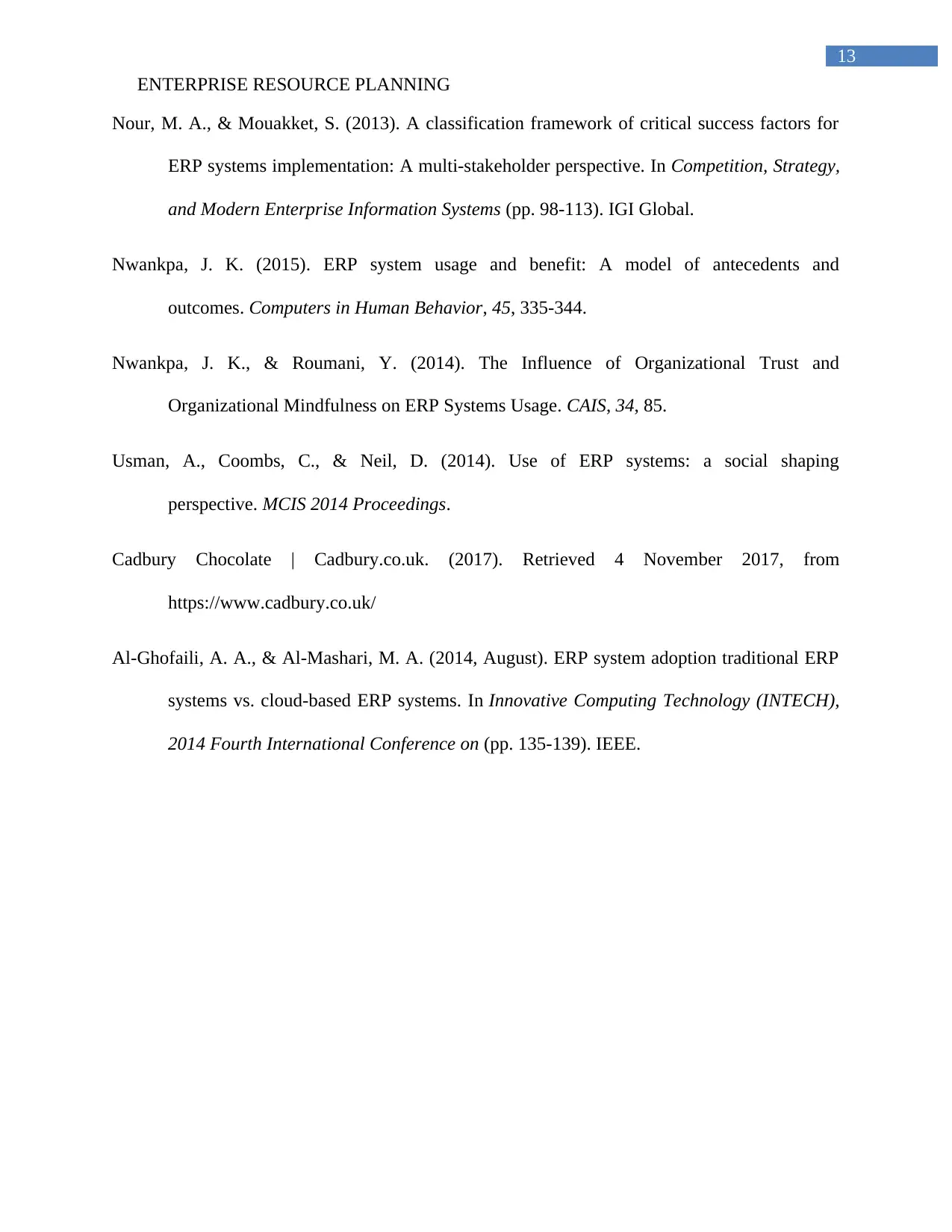
13
ENTERPRISE RESOURCE PLANNING
Nour, M. A., & Mouakket, S. (2013). A classification framework of critical success factors for
ERP systems implementation: A multi-stakeholder perspective. In Competition, Strategy,
and Modern Enterprise Information Systems (pp. 98-113). IGI Global.
Nwankpa, J. K. (2015). ERP system usage and benefit: A model of antecedents and
outcomes. Computers in Human Behavior, 45, 335-344.
Nwankpa, J. K., & Roumani, Y. (2014). The Influence of Organizational Trust and
Organizational Mindfulness on ERP Systems Usage. CAIS, 34, 85.
Usman, A., Coombs, C., & Neil, D. (2014). Use of ERP systems: a social shaping
perspective. MCIS 2014 Proceedings.
Cadbury Chocolate | Cadbury.co.uk. (2017). Retrieved 4 November 2017, from
https://www.cadbury.co.uk/
Al-Ghofaili, A. A., & Al-Mashari, M. A. (2014, August). ERP system adoption traditional ERP
systems vs. cloud-based ERP systems. In Innovative Computing Technology (INTECH),
2014 Fourth International Conference on (pp. 135-139). IEEE.
ENTERPRISE RESOURCE PLANNING
Nour, M. A., & Mouakket, S. (2013). A classification framework of critical success factors for
ERP systems implementation: A multi-stakeholder perspective. In Competition, Strategy,
and Modern Enterprise Information Systems (pp. 98-113). IGI Global.
Nwankpa, J. K. (2015). ERP system usage and benefit: A model of antecedents and
outcomes. Computers in Human Behavior, 45, 335-344.
Nwankpa, J. K., & Roumani, Y. (2014). The Influence of Organizational Trust and
Organizational Mindfulness on ERP Systems Usage. CAIS, 34, 85.
Usman, A., Coombs, C., & Neil, D. (2014). Use of ERP systems: a social shaping
perspective. MCIS 2014 Proceedings.
Cadbury Chocolate | Cadbury.co.uk. (2017). Retrieved 4 November 2017, from
https://www.cadbury.co.uk/
Al-Ghofaili, A. A., & Al-Mashari, M. A. (2014, August). ERP system adoption traditional ERP
systems vs. cloud-based ERP systems. In Innovative Computing Technology (INTECH),
2014 Fourth International Conference on (pp. 135-139). IEEE.
1 out of 14
Related Documents
Your All-in-One AI-Powered Toolkit for Academic Success.
+13062052269
info@desklib.com
Available 24*7 on WhatsApp / Email
![[object Object]](/_next/static/media/star-bottom.7253800d.svg)
Unlock your academic potential
© 2024 | Zucol Services PVT LTD | All rights reserved.





